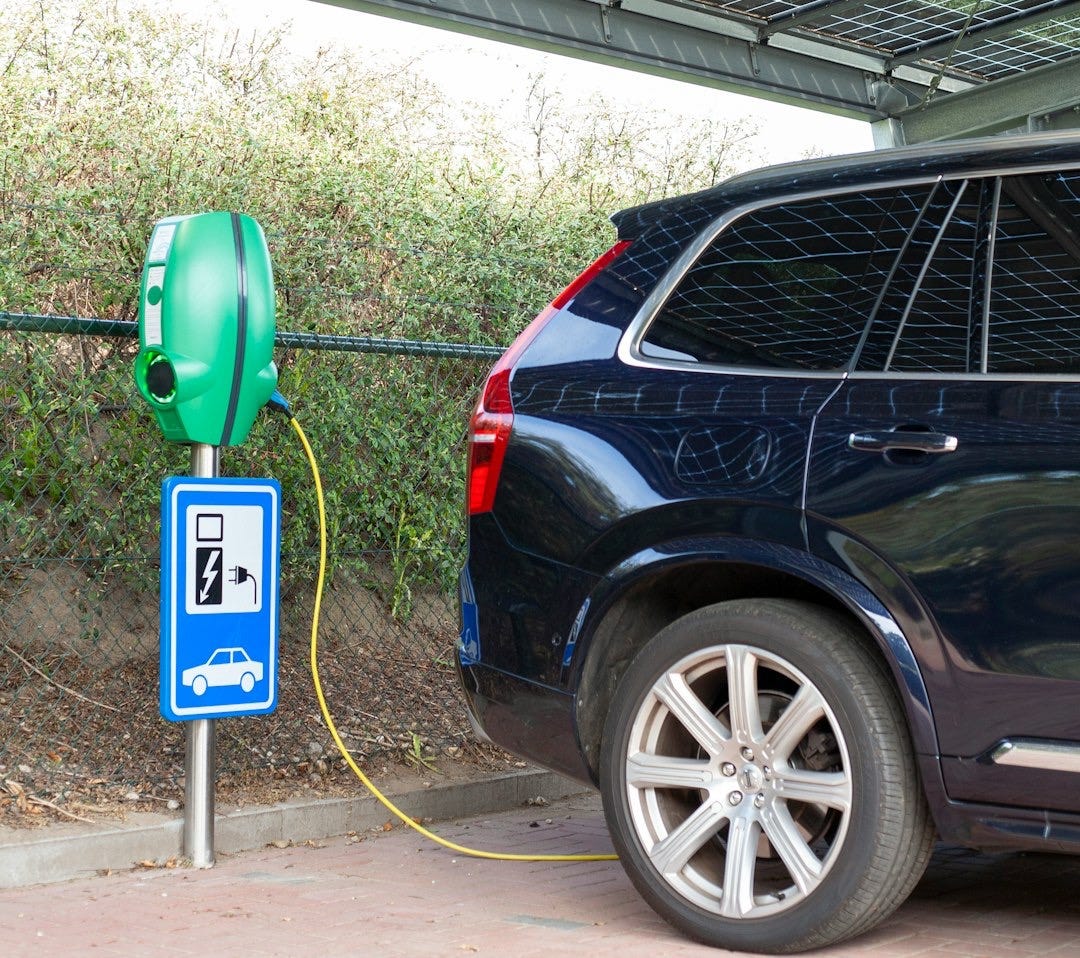Weak Infrastructure
The future is here, but the self-proclaimed "free market" enthusiasts want to keep us all in the past.

A truth not yet universally acknowledged: the internal combustion engine is dying. It lives on, gasping even as it poisons the air; it is kept alive, partly by habit, partly by an EV market that is only now developing fully; and partly, it must be said, by entrenched financial interests: I mean, of course, the financial interests of the ruling political class, which depends so much on campaign donations from the fossil fuel industry. You don’t have to take my word for it: here’s a Nobel Prize winning economist on the subject:
Republicans in general and Trump in particular like fossil fuels and dislike renewables. Some of this is about money: In the last election cycle the oil and gas industry gave 88 percent of its contributions to Republicans. And as I wrote last month, energy policy has been caught up in the culture wars. Solar and wind power have, in the MAGA mind, become identified with wokeness, while burning fossil fuels is considered masculine. Hence the hostility to green energy.
Never mind that the climate-change doomsday countdown clock has the apocalypse — the actual one that threatens the actual world — less than four years away. Apparently the idea of non-extractive, non-polluting, renewable energy — where profit derives not from gallons of poisonous volatile organic compounds but from the sale and maintenance of equipment like windmills and solar panels — is for snowflakes. And the obvious fact that the fossil fuel will, eventually, run out completely is a problem for another day. The New York Times reports that Alaska’s largest city could soon go dark, when the gas from the Cook Inlet runs out. The proposed remedy — a pipeline from the North Slope — simply kicks the can down the road a few more years.
In a recent conversation with neighbors — the monthly block happy hour — someone mentioned the sheer joy of driving a stick, and half-heartedly lamented that it would soon enough be a skill (and necessity) lost to the mists of history. Glance casually at an automobile dealer sticker — the list of standard and optional installed features — and you’ll be struck by the transmission listed for an electric vehicle: 1-speed. What??? It forces us to think, for just a moment, about what that means: in a world of 4-speed automatics and 5-speed sticks, one speed sounds primitive. Regressive, even.
That 1-speed is hardly regressive, it turns out. Anyone who has ever struggled with a short on-ramp or dicey merge (most drivers, especially here in the land of Robert Moses’s parkways) will immediately appreciate the single-speed EV, with its fast pickup and zero emissions: it certainly feels faster than any conventional car I’ve driven (including a stick). There are now many more EVs on the road, and not just rhymes-with-Messla. GM, Ford, Subaru, KIA, Hyundai, VW, Audi, BMW, Volvo — I see them all over the streets of New York and elsewhere. In the last two years the market, availability, and variety of EVs has exploded. Are they perfect? No, but they are getting better very quickly. I’ve taken trips that exceed my car’s nominal 250-290 mile range (depending mostly on whether climate control is on or off, and the outdoor temperature) without a hitch. Does it require a little extra planning? Yes. Have I ever had a problem finding a place to plug in? Absolutely not.
That said: what is missing now is infrastructure. It would be vastly easier if we didn’t have to take that extra five minutes before a trip: where are the available public chargers? How far can we go before needing, really needing, a fill-up? Should we alter our usual route in any way? These are (obviously) not concerns when driving a conventional internal combustion vehicle: the retail infrastructure is well established, having been built out over the 125 years. One reason: in the early 1900s the United States government actively encouraged the fossil fuel industry with price supports, favorable mineral rights, and more. It also encouraged competition through the vigorous enforcement of the antitrust laws, breaking up the Standard Oil.
In London there are over 25,000 street kiosks; in New York City, there are fewer than 10,000. That the EV-charging infrastructure here in the US is not better-developed is shameful, if understandable. This will change, with or without federal assistance, but it’s fair to say that it will be slower without the incentives and encouragement of the Biden Administration.1
Still, it will happen. In Kansas City I saw at least half a dozen public chargers within walking distance of my hotel, along one street. The auto companies have seen the future, and it is not internal combustion. The District of Columbia is on board, even if the federal government isn’t: there are about 1,200 stations so far, and about half of those are fee-free. The cost of charging is already less than gasoline. “Free” reduces the EV driver’s costs even more, adding — ahem — fuel to the fire.
It’s not about being woke, it’s about being practical. While the cultists sip their Kool-Aid and jeer, the world moves on. For now, it moves on without the United States, a tragedy as predictable as it was avoidable.
The cultists are loud, but the truth is: they do not have the numbers. The country will, eventually, move on without them.
During this incumbent’s first term, he complained loudly — beginning with his inaugural address, and right through the next four years — about American’s crumbling infrastructure. The self-proclaimed “builder president” promised a $1.5 trillion investment; after four years the reality was far, far short of expectations: requiring localities to kick in 80% of “a $1 billion program” suggests that “federal investment” isn’t so much a program as it is a slogan trying to capitalize on state investment that’s already under way.

